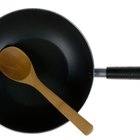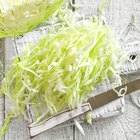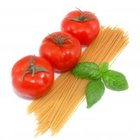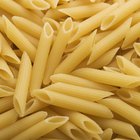svariophoto/iStock/GettyImages
Noodles release starch while cooking in boiling water, which causes the noodles to stick together. This is especially problematic with long, thin noodles and when cooking large amounts of noodles in a crowded pot. The key to preventing pasta from sticking together is ensuring there is enough room in the pot to stir the pasta and for water to pass between the noodles.
Fill a pot with 4 to 6 quarts of water for every 1 pound of noodles you plan to cook. Use multiple pots to cook the pasta, if needed, rather than trying to add too many noodles to a smaller pot.
Add 1 to 2 tablespoons of salt to the water to add flavor to the pasta. Bring the salted water to a rolling boil.
Add the pasta to the water when it reaches a rolling boil. Stir the pasta thoroughly to keep it from sticking while rinsing the starchy coating that develops immediately upon entering the water. You can add large amounts of pasta one handful -- about 1/2 pound of spaghetti -- at a time if it makes it easier to stir, but you must get the pasta in the water quickly to prevent uneven cooking times between the first and last handful.
Stir the pasta continuously for the first 2 minutes after adding it to the boiling water, ensuring that the pasta is constantly in motion so pieces of pasta don't cook together while the starch washes away from the outer coating. Stir with a pasta fork or pasta server, which looks much like a slotted spoon, but has tines around the edges that make it easier to pick up pasta and can even comb through and separate noodles.
Stir the pasta at least once every minute after the first two minutes until done. Noodles generally take 7 to 12 minutes to cook to "al dente," in which the noodles are still somewhat firm and chewy, but you might prefer the noodles a little softer. Exact cooking times vary greatly with different pasta sizes and shapes.
Drain the water from the pasta and immediately stir in hot sauce while the pasta is still hot and before the remaining starch in the pasta crystallizes. Hot noodles are better able to absorb sauce for better flavor, but adding the sauce before the starch crystallizes also prevents the cooked noodles from sticking together as they cool.
Related Articles

How to Cook Spaghetti to Use the Next ...

The Best Way to Cook Spaghetti Noodles

How to Cook Vermicelli Noodles Without ...

How to Boil Pasta Noodles

How to Make Mac & Cheese Using Alfredo ...

How to Cook Lasagna Noodles Al Dente

How to Cook & Freeze Spaghetti Noodles

How to Cook Orecchiette

How to Freeze Spaetzle

How to Fry Raw Spaghetti

When to Add the Noodles in a Crock Pot ...

How to Cook Luglug Cornstarch Noodles

Can I Pour Hot Water in a Baking Dish ...

How to Cook Pasta in the Microwave or ...

How to Cook Cabbage & Noodles in a ...

How to Make a Quick Snack Made of Ramen ...

How Long to Cook Fettuccine for Al ...

How to Make Spaghetti Noodles

Calories in Pasta Noodles

How to Cook Miracle Noodles in the ...
References
Tips
- Standard 8-quart stock pots work well for cooking 1 to 2 pounds of pasta at a time, but a larger pot or multiple pots are needed for cooking several pounds of pasta at once. Try using a soup pot or stock pot with a capacity of 12 to 20 quarts or more.
Writer Bio
A former cake decorator and competitive horticulturist, Amelia Allonsy is most at home in the kitchen or with her hands in the dirt. She received her Bachelor's degree from West Virginia University. Her work has been published in the San Francisco Chronicle and on other websites.